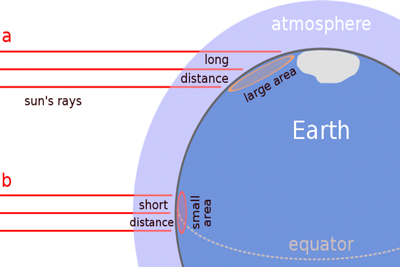
The latitudes play a vital role in determining the temperature of the atmosphere. The Sun does not heat the Earth uniformly. Places near the equator get more or less direct rays of the Sun, while places far away from the equator receive more and more slanting rays.
The direct rays are far more powerful than the slanting rays. Moreover, within the tropics the rays are concentrated on a smaller area and pass through lesser part of atmosphere. However, outside the tropics, the rays are spread over a large area, pass through a longer distance and consequently, much of the heat is absorbed by clouds, water vapour and dust particles. Hence, temperature gradually decreases from the equator to the poles. In other words, places located at high latitudes or far from the equator, receive slanting rays which have less heating power than the places at low latitudes, which are close to the equator.

We are aware that, the rays of the Sun heat the Earth and the heated Earth in its turn, warms the layers of air just above it by conduction. In fact, the temperature of the surrounding air makes us feel warm or cold. Since the atmosphere in the plain is denser, the ground remains warm, while at a higher altitude, where the atmosphere is thinner, the warmth of the ground is quickly lost and the air is cooler. In other words, the air temperature decreases with the increase of altitude.
If we imagine the layers of air as layers of blankets keeping the Earth warm, then a man living on the plain can be compared to a man sleeping under a large number of blankets, because he has the whole thickness of air above him. As he climbs a mountain, the atmosphere becomes thinner, in other words, the air blankets above him become less in number and only a few are left to keep him warm.
The temperature usually decreases from the sea level to the highest limit of the Troposphere at the rate of 1ºC per 166 metres or 0.6ºC per 100 metres. This rate of decrease is known as the ‘lapse rate of temperature’. So a mountain above 1000 metres high would be about 6ºC colder at the summit than at the base.